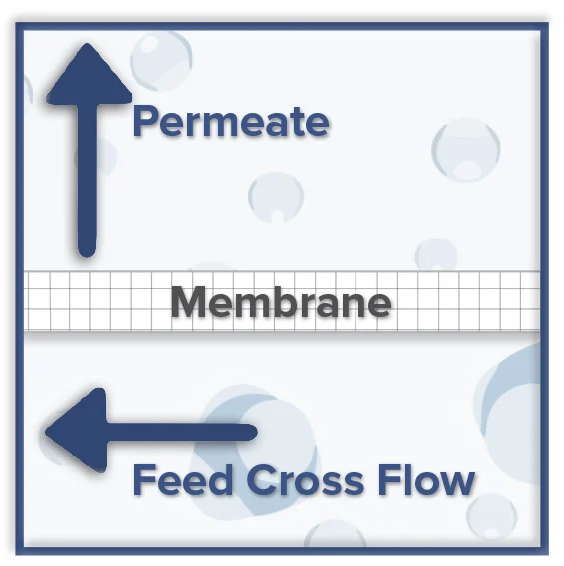
Filtration by membrane is an essential separation technique used to most commonly separate particles from liquid in a variety of applications and industries for the purpose of concentrating, recovering, or purifying. Food and beverage manufacturing, water treatment applications, biological field research, and other industries fall within this category. Crossflow filtration (CFF), also known as tangential flow filtration (TFF), and direct flow filtration (sometimes known as dead-end filtration), are two alternative filtering setups that serve different needs and application magnitudes.
What is crossflow/tangential flow filtration, and how does it work?
Crossflow filtration (CFF), often called tangential flow filtration (TFF), is a filtering technique in which the feed solution flows radially across the filter's surface. Some feed streams will pass through the membrane, while the rest will be concentrated and circulated through the system.
The feed is the solution that flows parallel to the membrane's surface. The permeate is the liquid that goes through a membrane. The concentrate, or retentate, is a solution that passes through the membrane and returns to the feed reservoir. This solution is typically recirculated and pumped back to the feed reservoir.
Ultrafiltration, nanofiltration, and reverse osmosis use crossflow filtration to achieve tighter molecule separations. Both filtration procedures are used to achieve microfiltration or the physical separation of suspended particles and germs from process fluids. Particles with molecular weights of 300-500 kilodaltons and diameters bigger than 0.1 micron are common. (2) CFF/TFF processes are straightforward, but implementation necessitates a thorough understanding of the system and subsequent successful implementation.
Is there a difference between the two frequently interchangeable terms? Basically, both function according to the same principles, and the change of name depends on the industry in which it is used. For water treatment applications, the filtering process is referred to as crossflow filtration. But in biological field investigations, it's known as tangential flow. The term TFF is also specifically used when describing protein purification for biopharmaceutical applications. (3)
Why CFF/TFF?
- Lower energy use means lower running costs
- Impurity removal requires fewer chemical additions
- Enhanced production efficiency and quality control
- Depending on the sample size, processes can be adjusted up or down
- Membrane housings are available in several coupon sizes
Sterlitech offers a comprehensive selection of commercially available polymeric flat sheet membranes, and housings, for cross flow/tangential flow filtration applications. View the entire line here.
Sources:
- Crossflow Filtration Handbook by Sterlitech
- https://www.pall.com/content/dam/pall/food-beverage/literature-library/non-gated/FBTADIRCROSSEN.pdf
- https://en.wikipedia.org/wiki/Cross-flow_filtration


![Join Sterlitech at BIO 2024 [Booth #5558]: Exploring the Future of Biotechnology](https://www.sterlitech.com/media/magefan_blog/b4.jpeg)

